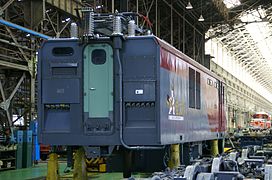JR Freight Class EH500
| Class EH500 | |||||||||||||||||||||||||
|---|---|---|---|---|---|---|---|---|---|---|---|---|---|---|---|---|---|---|---|---|---|---|---|---|---|
 EH500-31 at Koriyama Rolling Stock Centre in August 2010 | |||||||||||||||||||||||||
| |||||||||||||||||||||||||
| |||||||||||||||||||||||||
| |||||||||||||||||||||||||
| |||||||||||||||||||||||||
The Class EH500 (EH500形) is a Bo′Bo′+Bo′Bo′ wheel arrangement multi-system AC/DC two-unit electric locomotive type operated by JR Freight in Japan since 1997.[1][2]
Operations[edit]
The locomotives are built at the Toshiba factory in Fuchū, Tokyo. Initially, they were all based at Sendai depot for use on long-distance container trains from the Tokyo area to Hokkaido via the Tohoku Main Line, replacing DC Class EF65s south of Kuroiso, pairs of AC Class ED75s north of Kuroiso, and pairs of AC Class ED79s through the Seikan Tunnel.[1]
In 2004, locomotives EH500-25 and EH500-27 were loaned in turn to Moji depot in Kitakyushu for trials. From 2007, a number of EH500s were transferred to Moji depot for use on 1,300 tonne freight trains between Honshu and Kyushu through the Kanmon Tunnel, replacing ageing AC Class ED76s and dual-voltage EF81-300s and EF81-400s.
As of 1 April 2013[update], the fleet totalled 82 locomotives (EH500-901 and EH500-1 to EH500-81).[3] 12 locomotives, EH500-45 to EH500-50 and EH500-67 to EH500-72, are based at Moji Depot, and the other 70 members of the class are based at Sendai.[4]
Variants[edit]
- EH500-901: Prototype
- EH500-1 – 2: Pre-series 1st batch
- EH500-3 – 9: Full-production 2nd batch
- EH500-10 –: 3rd batch
EH500-901[edit]
The prototype, EH500-901, was delivered to Sendai depot in September 1997 for extensive testing on the Tohoku Main Line and Kaikyo Line until March 1999.[2] The livery is red and grey with black cab surrounds.[2] It joined the rest of the Class EH500 fleet for use on revenue services from the start of the March 2000 timetable revision.[2] "Kintaro Eco-Power" logos were added to the sides from December 2002.[2]
-
Prototype EH500-901 in November 2015
1st batch: EH500-1 and EH500-2[edit]
Two pre-series locomotives, EH500-1 and EH500-2, were delivered in March 2000.[2] These locomotives are finished in a livery of maroon and grey with black cab surrounds.[2]
-
EH500-2 in August 2011
2nd batch: EH500-3 to EH500-9[edit]
Built from March 2000 to January 2001. The headlamps were moved to a higher position to reduce problems of blockage by snow.[1] New "Kintaro Eco-Power" logos were added to the sides.
-
EH500-8 in February 2022
-
Inner end of EH500-3 undergoing overhaul in May 2007
3rd batch: EH500-10 onward[edit]
Locomotives from EH500-10 (delivered in August 2001) onward are painted in a revised colour scheme using bright red instead of the earlier maroon colour. The black colour around the cab windows was also discontinued.[1] Locomotives numbered EH500-15 onwards have narrower surrounds on the front-end headlight boxes, and the front-end white band is also correspondingly slightly thinner.[1]
-
EH500-16 in January 2017
-
EH500-77 in February 2022
-
EH500-38 in December 2011 with a "Do your best Tohoku!" sticker added after the 2011 Tohoku earthquake
Classification[edit]
The EH500 classification for this locomotive type is explained below. As with previous locomotive designs, the prototype is numbered EH500-901, with subsequent production locomotives numbered from EH500-1 onward.
- E: Electric locomotive
- H: Eight driving axles
- 500: AC/DC locomotive with AC motors
See also[edit]
References[edit]
- ^ a b c d e Jr機関車カタログ: Jr7社の現有30形式を詳しく解說 JR機関車カタログ [JR Locomotive Catalogue]. Japan: Ikaros Publications Ltd. 20 June 2013. pp. 72–74. ISBN 9784863207271.
- ^ a b c d e f g Jēāru zensharyō handobukku: Rail Magazine 2009 JR全車輌ハンドブック2009 [JR Rolling Stock Handbook 2009]. Japan: Neko Publishing. 2009. pp. 53–54. ISBN 978-4-7770-0836-0.
- ^ Kisumi, Kenzo (April 2017). 世代交代が進むJR貨物の機関車 [Advances in handover between generations for JR Freight locomotives]. Tetsudo Club (in Japanese). Vol. 2. Japan: Cosmic Publishing. p. 98. ISBN 978-4-7747-8338-3.
- ^ Shibata, Togo (August 2016). 最新JR貨物の電気機関車と話題の貨物列車 [Latest: JR Freight electric locomotives and popular freight trains]. Tetsudo Daiya Joho Magazine (in Japanese). Vol. 45, no. 388. Japan: Kotsu Shimbun. p. 33.








